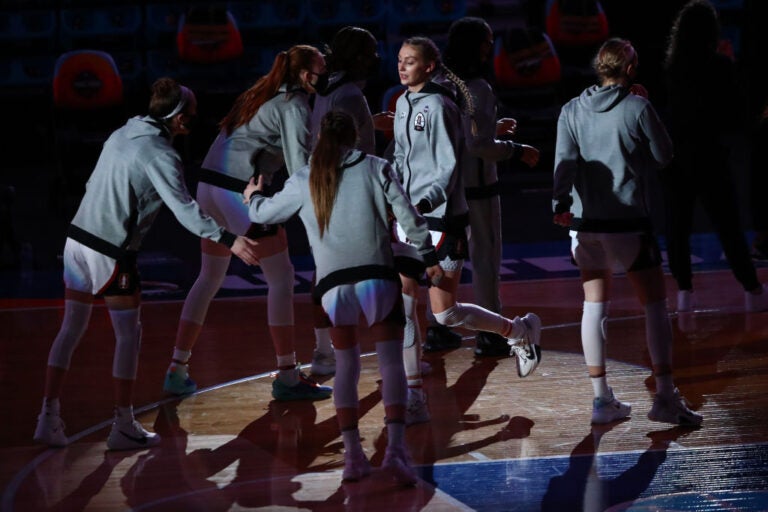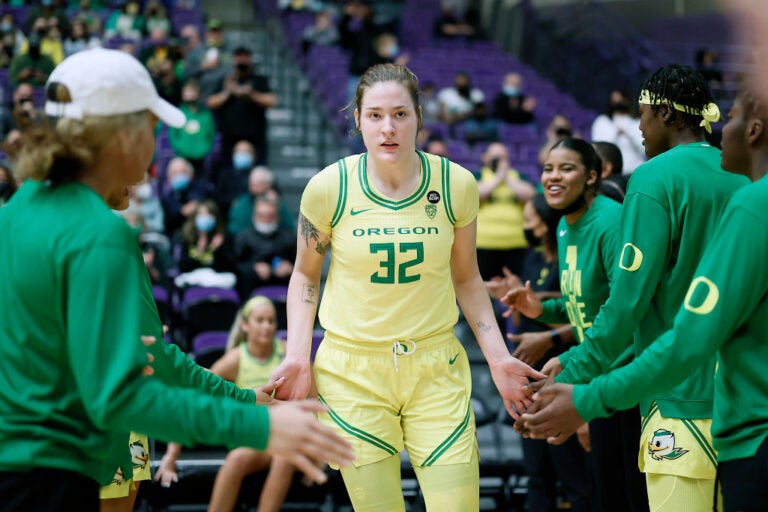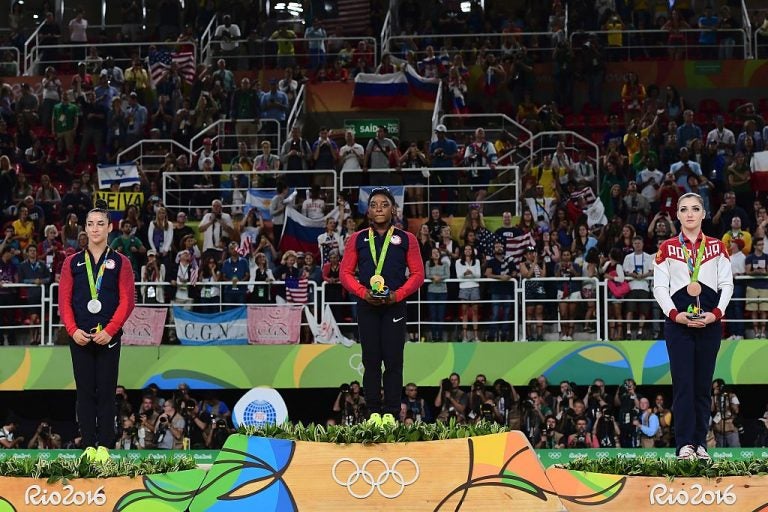What We Can Learn From the Harmful Body-Shaming Culture Around the University of Oregon Track Program
Why this matters
While old training and medical axioms finally have been set aside for more individualized treatment and physical maintenance in modern sport, the abuse in the track program at the University of Oregon shows how pervasive that outdated mindset still is, even at the highest levels of competitive athletics.
Last October, reporter Ken Goe of The Oregonian published a story in which six women athletes who left the University of Oregon’s track program said that the program’s emphasis on weight and body fat percentages created a dangerous culture of disordered eating.
I was one of those athletes.
When Goe approached me about participating in the article, I didn’t hesitate to tell him about my experience. While I never suffered from disordered eating myself, I knew what I saw and experienced during my time on the team wasn’t healthy. I also knew it needed to change. In fact, I had been internally critical of the program’s focus on body composition for years, frequently having conversations with coaches and also reporting the program’s practices to several administrators.
I’m sharing my story now, publicly, because I believe Oregon still has a long way to go in understanding eating disorder culture and prioritizing athlete health and well-being.
In January 2017, midway through my sophomore year, I transferred from Vanderbilt University to Oregon. I was drawn to the school because of its storied history and ongoing success in track and field – under head coach Robert Johnson, Oregon has won 14 National Collegiate Athletic Association championships since 2012. I was searching for a more elite program that would develop me into an All-America high jumper, and Johnson’s professional approach to training fit the bill.
Johnson is a phenomenal technical coach. Training at Oregon is methodical and scientific, designed to maximize speed, strength, and power to develop well-rounded athletes. It delicately balances plyometrics, conditioning, strength training, and recovery. I was particularly impressed with our fall training, which gradually built to heavier loads to prevent injury and to help new athletes adjust to a rigorous training schedule. We had the latest technology at our disposal, too, allowing us to regularly measure performance benchmarks like 30-meter dash times and force input into the ground.
However, the program’s approach to body fat percentage – a focus on reaching certain numbers, and the methods used to achieve that – is misguided at best. At worst, it’s downright dangerous. And while Johnson says that it is rooted in sports performance science, in my experience the target numbers were arbitrary and detrimental to performance.
Arbitrary Benchmarks and Harmful Policing
It’s impossible to understand the culture at Oregon without understanding DEXA scans.
A DEXA scan is a type of medical imaging test that doctors mostly use to precisely measure overall bone density, which in turn helps them diagnose osteoporosis as well as the risk of having a broken bone in the future. My first DEXA scan at Oregon happened after I injured my knee on my first day of practice. Our nutritionist took a scan of just my forearm – DEXA scans were always administered by the team nutritionist – and that was enough to determine my bone density was in a healthy range.
Oregon also uses full-body DEXA scans to precisely measure body fat percentage. And that, I believe, is a problem. These scans were a regular practice across most sports at Oregon, but other teams placed little emphasis on them. Many athletes never even knew their results.
Track and field was different. Every member of the team would get a DEXA scan each quarter: at the start of the school year, after winter break, and again in March. The scans were a big deal. During the week of our scans, people would panic. Everyone cleaned up their diet. Some people would add in extra workouts, like they were wrestlers trying to make weight. The ideal time slot for a DEXA scan, we thought, was first thing in the morning or right after morning weights – because you hadn’t eaten yet and your muscle mass would be maximized from lifting, leading to the best results.
After my first full-body DEXA scan, I was immediately told by our nutritionist to decrease my body fat percentage from 21 percent down to around 16 percent. Our nutritionist advised us to cut body fat percentage by increasing protein intake to convert fat to muscle mass, but it was the coaching staff that dictated the standards governing body fat percentage.
Related: Sport Gives Girls the Space to Define Themselves
Coaches would ask about your scan at practice, and then your body fat percentage would be weaponized against you throughout the whole year. A good body fat percentage meant you were training hard, lifting heavy, and eating clean. If your body fat percentage was too high, the assumption was that you weren’t doing those things.
The target number for body fat percentage will vary based on who you ask, but my understanding is the coaches wanted female athletes below 16 percent. Men were also given a target somewhere around 10 or 11 percent. According to Goe’s article, the American Council on Exercise suggests an ideal body fat percentage for a female athlete is between 14 percent and 20 percent. Excessively low body fat can lead to Relative Energy Deficiency in Sport, or RED-S, which can cause fatigue, decreased bone health, and amenorrhea in women. RED-S is known to contribute to bone injuries such as stress fractures, which notoriously plague track and field athletes.
I was told by Johnson that Oregon calculated its targets by averaging the body fat percentages of professional athletes – specifically, Olympic and world championship medalists – and then adding a few percentage points to account for the fact that we were college athletes. I’m not sure where they were getting those percentages from, because they are not public knowledge. I was also confused why everyone on the team was striving to reach the same benchmark. Professional athletes are able to determine their ideal weights based on years of personal experience, and they know how to strategically peak their nutrition and training during championship season.
Meanwhile, we were asked to reach and maintain an arbitrary benchmark year-round. Even freshmen were expected to reduce their body fat percentage within their first weeks of being on campus.
Body Fat Vs. Health
This emphasis on body fat percentage played out in many ways. In the fall, the coaches would assign extra cross-training if your percentage was considered too high. Usually, this consisted of an extra bike workout three times a week after practice. In my experience, cross-training applied only to women, despite the fact that there were men on the team who were known to have a body fat percentage that was also “too high.”
At the beginning of the year, our coaches would also give us composition notebooks to track our training and nutrition. We were supposed to track what we ate, when we ate it, the workout we did at practice, how we felt at practice, when we went to sleep, and when we woke up. On its face, that type of log is typical for any elite athlete, and it can be extremely beneficial. It’s good to know how your sleep and nutrition are impacting your training, and a log can help identify negative patterns that need to be changed, like failing to fuel after a workout or not getting enough sleep. But Oregon’s coaches would collect those diaries, review them, and give feedback. They would occasionally hand out diets, and athletes would be punished if they didn’t turn in their logs at practice.
People would do anything to trim their body fat percentage, resorting to diets that I’m sure our team nutritionists would not have endorsed had they known about them. Some would try to cut out carbohydrates. A few people relied on natural appetite suppressants. Nobody would eat dessert. No juice. No soda. Only water. There was always a conversation about whether or not you had earned yourself a waffle for breakfast after morning weights.
And some of these restrictions were driven by the coaches. One coach told a teammate, who was a freshman at the time, that she didn’t make indoor nationals because she was too fat. Johnson had one athlete carry around a gallon of water to drink every day, because if she was more hydrated, she wouldn’t be as hungry. Another coach had a diet that they would hand out to his athletes that included things like only drinking water and no eating after 9 p.m.
On one occasion, during a road trip to the University of Washington, we stopped in a small town called Centralia for dinner. Our options were Safeway, Jack in the Box, and Starbucks. Some people would pack a lunchbox for the road, but most of us would find whatever hot food or premade salad we could at Safeway. A few people went to Jack in the Box. At our next practice, Johnson yelled at the team for going to Jack in the Box and told everyone that if their body fat percentage was above a certain percentage, they were not allowed to eat fast food.
Even though I was immediately told to lose body fat when I came to Oregon, I never felt like I needed to. I was always extremely skinny as a kid, and most of my life coaches and doctors told me to put on more weight. In fact, weeks before transferring to Oregon, my doctors at Vanderbilt encouraged me to gain weight because I was dealing with recurring stress fractures. At Oregon, I continued to deal with a chronic knee injury. Had I been healthier and traveling more, I’m certain the coaches would have put more pressure on me to lose body fat. And part of me just didn’t care. I knew I was eating well. I knew I was training hard. And that’s all I needed to know. Whether or not that reflected in my body fat percentage wasn’t very important to me.
But for some of my teammates, weight and body fat percentage was everything. I do not blame those teammates for doing everything they could to lose weight. They were training hard at practice, doing the extra workouts, eating what they thought was healthy. The only factor left was body fat percentage. They did what the coaches told them they needed to do to win.
It should go without saying that body fat percentage was not a predictor of Pac-12 and All-American success on our team. Some of our best athletes were constantly told their body fat percentage needed to be lower. Women of all body types succeeded and failed at every level.
Part of a Bigger Pattern
In a 2019 New York Times video op-ed, professional runner Mary Cain told the world that emotional abuse and body-shaming by Nike Oregon Project coach Alberto Salazar caused her to develop severely restrictive disordered eating and long-term physical and mental health problems. The story triggered national conversation about the prevalence of eating disorders and abusive coaching in track and field. Since Cain came forward, the Nike Oregon Project has been disbanded, and Salazar has been permanently banned from competition by the U.S. Center for Safesport.
When the Cain story broke, Johnson initiated several discussions about weight and body fat percentage tracking with athletes at practice. Over a period of weeks, I spoke to him extensively about it. To his credit, initiating the conversation was a major step in the right direction. He wanted to know: Is what we’re doing wrong? Is it wrong for me to be measuring body fat percentages? Should we never mention an athlete’s weight?
Related: Women in the Undercurrent of Sport Are Thriving
Yet most of the conversations I had with Johnson were disturbing. At one point, he claimed that only cross country athletes on the team had eating disorders, stating that the track side of the team “had a problem with being too heavy.” He suggested that losing weight was not as difficult as the athletes made it seem; all you had to do was be in a calorie deficit. He also encouraged me to avoid eating protein bars that the nutrition staff provided because they were unhealthy. Why? The calorie count was too high.
After a few weeks, Johnson texted me an article written by Jen Rhines, a former professional track athlete who detailed her positive experience as a professional athlete tracking weight and body composition. From that article, Johnson concluded that weight and body fat percentage were necessary factors for him to evaluate as a coach because of the impact they have on performance. He never brought up Cain at practice again.
From our conversations, I realized a few things about Johnson. First, he is extremely steadfast in his coaching practices that have brought him significant success, and that includes tracking body fat percentage. As such, any eating disorder that results is likely to be blamed on the athlete rather than the environment that allowed the eating disorder to flourish. Second, and most alarmingly, he lacks a basic understanding of nutrition and eating disorders that is extremely dangerous to his athletes. Assuming that an eating disorder can present only as an underweight athlete prevents him from identifying negative behaviors that may need treatment, and his failure to recognize disordered eating as a problem reflects a restrictive culture that permeates the track program and can lead to under-fueling, injuries, and poor performance.
I also brought my concerns to several people in Oregon’s athletic department. Student-athlete development coordinators encouraged me to report the problem to administrators, but I ultimately decided not to in order to protect the privacy of my teammates who did not want to come forward. When I graduated in 2020, I mentioned the problem in my exit interview with athletic director Rob Mullens and again in an anonymous graduation survey conducted by the athletic department. In October 2020, when I learned from teammates that the problem had not been addressed, I drafted an email to associate athletic director Lisa Peterson sternly expressing my concerns about the overemphasis on body composition and the negative impact it has on the physical and mental health of athletes. That email prompted an investigation by the university’s faculty athletic representative, though I’m unaware if that investigation resulted in any policy changes.
Between Discipline and Disaster
When The Oregonian published its article this past October, I was relieved that so many people supported us and validated that what happened in our program was not healthy. I was encouraged by other athletes, like Katie Rainsberger and Phily Bowden, who came forward to corroborate our story and share their own. Yet I was troubled by the public response, which assumed the women in the article were cross country athletes and reverted the conversation to eating disorders in distance running. Eating disorders are known to be pervasive in endurance sports, but our story exposed another layer. Body fat percentage is just weight loss in disguise – a “better” but equally destructive way of controlling female athletes’ bodies, targeted at the particular insecurities that sprinters and jumpers hold.
Since the article was published, Oregon has changed its rules around testing body fat percentages. The school says that athletes can still choose to be tested, but that results “should not be reported beyond the student-athlete, dietitian and relevant medical personnel. Reporting of individual results to coaches is not permitted.” In my email to Peterson, I recommended that the coaches be walled off from nutrition conversations, including eliminating nutrition logs, diets, and access to DEXA scan results. The new policy is certainly a step in the right direction to protect athletes. But eliminating the problem entirely requires a massive change of the program’s culture around weight and body fat percentage. So long as the coaches believe that body fat percentage is a key performance indicator, the power they have over athletes will ensure that the problem persists. DEXA scans will be strongly encouraged, and athletes will likely share those results with the coaches out of fear of the assumptions that will be made about them if they don’t. Oregon must implement mandatory eating disorder training for coaches and support staff.
Should coaches discuss body weight? I have no doubt that these discussions can happen in a healthy manner in certain settings, but I do not believe college sports is one of them. Weight and weight loss in sport should always be an individual decision, and while that can be appropriate for some in the professional ranks, the power imbalance that exists between a college coach and a young athlete, coupled with an already persistent and toxic diet culture, creates an environment ripe for eating disorders.
There is an extremely fine line between discipline and disaster. We can argue about whether body composition has any true effect on performance, but at the end of the day the conversation shouldn’t be about performance enhancement. The potential for catastrophic damage is too high. While monitoring body fat percentage may be beneficial for some, the question is whether the success of one athlete is worth the damage it can do to another. Objectively, overemphasis on weight and body fat percentage is proven to have negative long-term health and performance consequences. Eating disorders have the highest mortality rate of any mental illness. Shaving a few milliseconds off an athlete’s 100 meter time is not worth the potential harm to their physical and mental well-being.
Monthly Issue
Sport & the Body
The body is the most fundamental component of sport, capable of unthinkable feats and requiring considerable care. Athletes continually push their bodies to the brink in order to excel at their craft, and the 21st century has brought about a reimagining of the limits of physical ability.
Yet as the world of sport intensifies its focus on the body, athletes are demanding better care, more freedom, and increased flexibility around how they maintain and shape theirs.
Related





